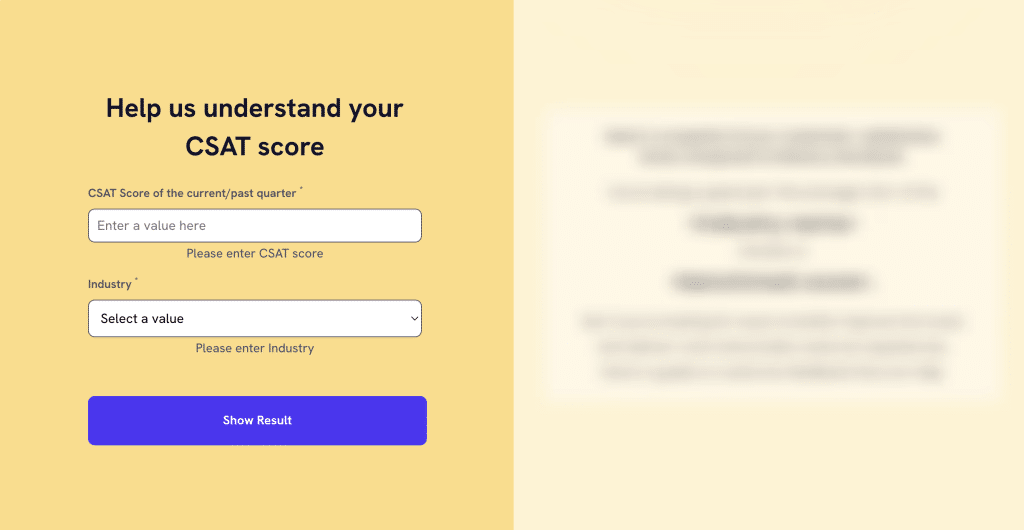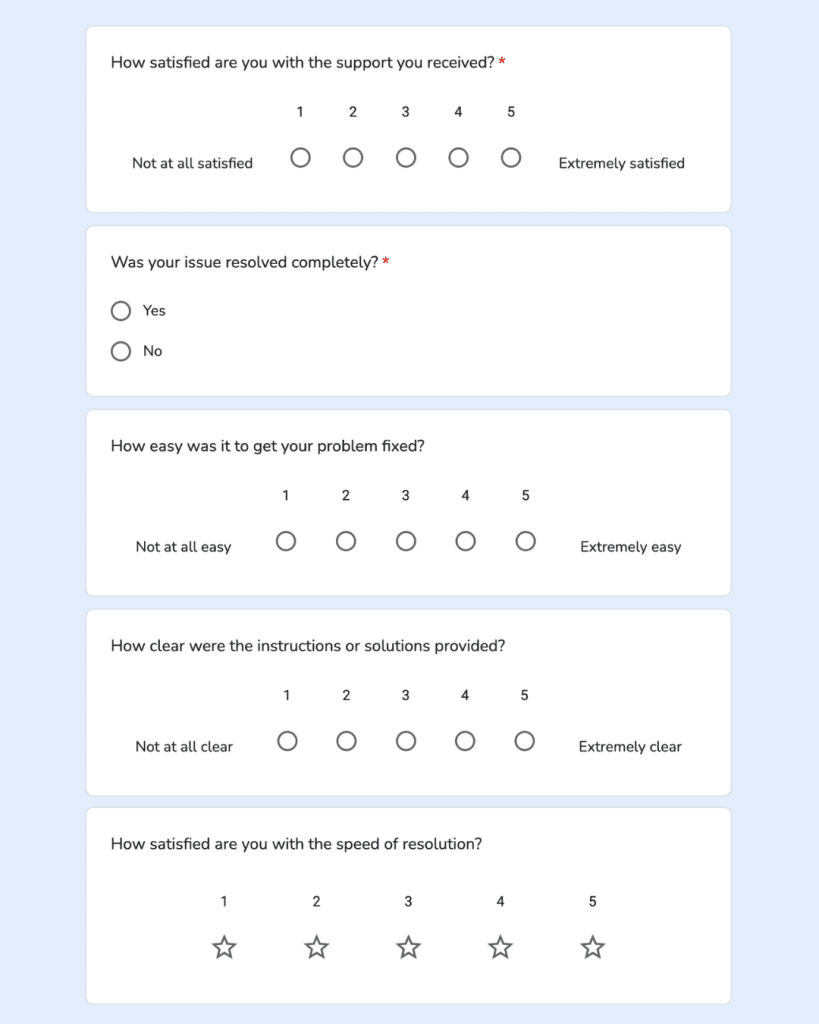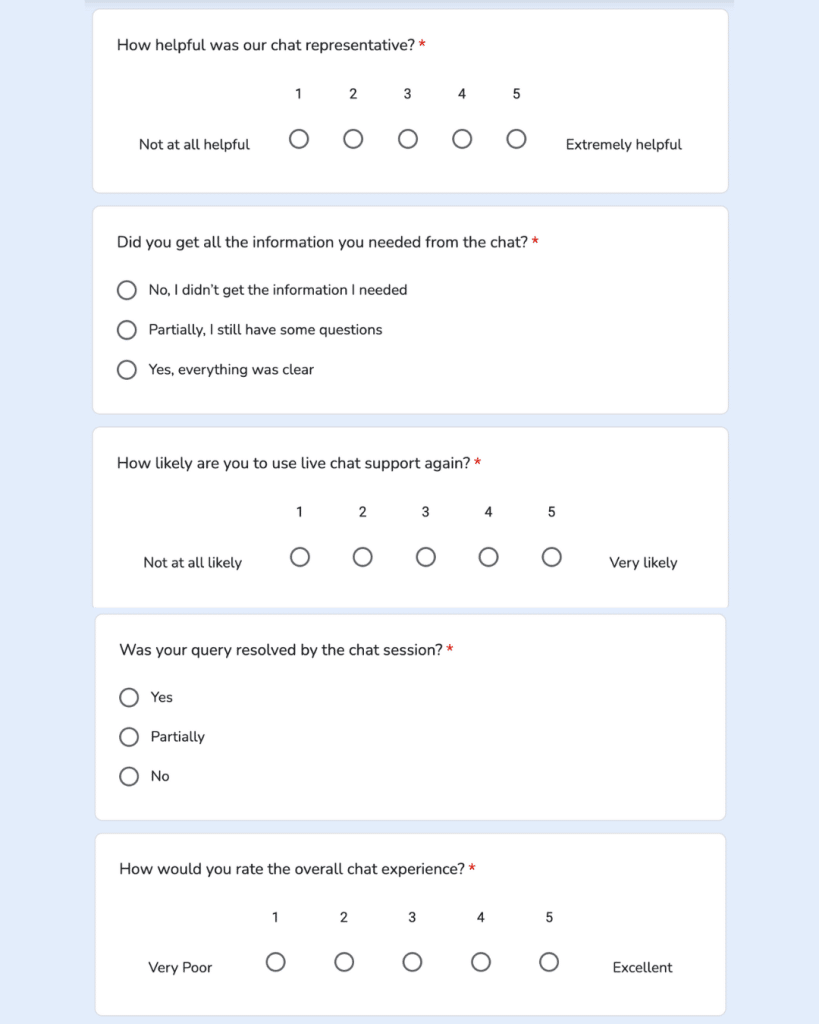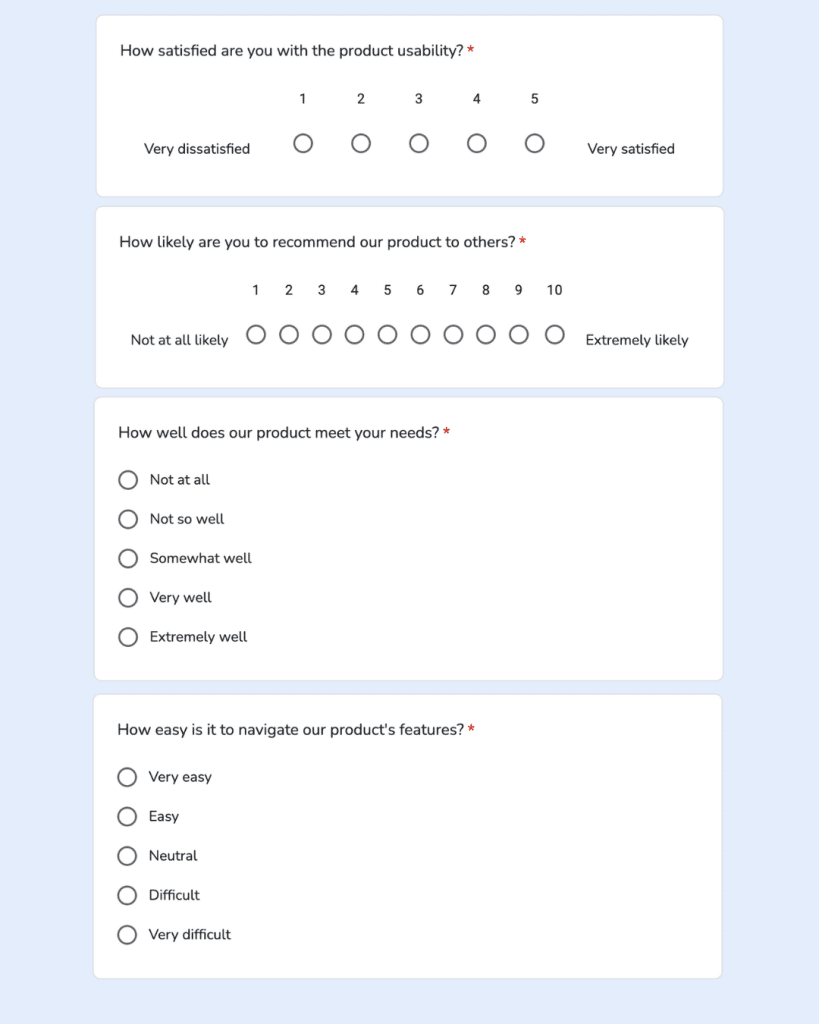Understanding how satisfied your customers are is one of the most important steps in improving support quality. A Customer Satisfaction (CSAT) survey is a simple yet powerful tool that captures this feedback directly from customers usually right after an interaction with your team.
CSAT surveys give you a clear, numeric score that reflects how well your support team is meeting customer expectations. When paired with open-ended questions, they also reveal why customers feel the way they do, helping you pinpoint issues and improve service delivery.
Well-crafted surveys capture the why behind the score, whether it’s speed of resolution, agent empathy, or product usability. Tracking these insights over time helps teams:
- Pinpoint recurring friction points that frustrate customers
- Spot training or process gaps that lead to poor support outcomes
- Prioritize improvements that directly impact customer loyalty
- Celebrate wins and recognize high-performing agents
In this guide, you’ll learn:
- What a CSAT survey is and how it works
- The benefits of using CSAT to measure customer satisfaction
- Ready-to-use CSAT survey templates and follow-up questions to collect actionable feedback
Whether you’re just starting with CSAT or looking to refine your surveys, these examples and templates will help you capture meaningful insights and build stronger customer experiences.
Table of Contents
- What is a CSAT survey?
- How CSAT surveys differ from NPS and CES
- Why CSAT surveys are essential for support teams
- 45 examples and templates for CSAT surveys
- Best practices to create an effective CSAT survey
- 10 follow-up questions to add after a CSAT survey
- Tips to improve CSAT response rates
- FAQs about CSAT surveys
- Final thoughts
What is a CSAT survey?
A Customer Satisfaction (CSAT) survey is a feedback tool businesses use to measure how satisfied customers are with a product, service, or recent interaction. It typically asks customers to rate their experience on a numerical scale, commonly 1 to 5 or 1 to 7, where higher numbers indicate greater satisfaction.
Purpose: CSAT surveys help teams understand customer experience, identify problem areas, and track satisfaction trends over time.
How it works: Customers are usually asked a question like “How satisfied were you with your recent experience?” or “How satisfied are you with [product/service]?”.
Scoring: Responses are collected using a rating scale, where low numbers indicate dissatisfaction and higher numbers indicate satisfaction.
Calculation: The CSAT score is calculated as the percentage of positive responses (e.g., 4 and 5 on a 5-point scale) divided by the total responses, multiplied by 100.
Actionable insights: Analyzing CSAT data helps businesses detect recurring issues, improve service quality, and enhance overall customer experience.
Recommended reading
How CSAT surveys differ from NPS and CES
CSAT, NPS, and CES are all common ways to measure customer experience, but they aren’t interchangeable. Choosing the right one depends on what you want to measure. CSAT focuses on how satisfied a customer is after a specific interaction. NPS helps track long-term customer loyalty. CES evaluates how easy it was for a customer to resolve an issue.
Understanding these differences will help your team pick the most effective survey for each stage of the customer journey. Here’s a quick table that explains the key differences between CSAT, NPS, and CES at a glance:
| Metric | What it measures | When to use it | Example |
| CSAT (Customer Satisfaction Score) | Customer satisfaction after a specific interaction | After support tickets, live chat, purchase | “How satisfied are you with your experience?” |
| CES (Customer Effort Score) | How easy it was for the customer to get help | After issue resolution or task completion | “How easy was it to get your issue resolved?” |
| NPS (Net Promoter Score) | Long-term customer loyalty | Quarterly or bi-annually | “How likely are you to recommend us to a friend or colleague?” |
Why CSAT surveys are essential for support teams
Customer Satisfaction (CSAT) surveys are more than just a metric; they are a direct line to understanding how customers feel about your service. For support teams, CSAT scores provide actionable insights that help improve response quality, agent performance, and overall customer experience.
A CSAT survey is typically sent after a support interaction. It asks customers to rate their satisfaction on a scale (e.g., 1 to 5 or 1 to 7). Tracking these responses over time allows teams to identify strengths, weaknesses, and patterns that impact customer loyalty.
Here’s why they’re essential:
✅ Measure real-time customer happiness
- Proactively monitor customer sentiment after every support interaction. For example, send a CSAT survey immediately after a ticket is resolved to capture how the customer feels while the experience is fresh.
- Action Tip: Set up automatic CSAT triggers for key touchpoints like live chat closure or ticket resolution.
✅ Identify service gaps
- Use CSAT scores to spot consistent low ratings and investigate the root causes whether it’s delayed responses, unclear communication, or unresolved issues.
- Action Tip: Analyze low CSAT scores by team, agent, or channel to pinpoint where performance needs improvement.
✅ Improve agent performance
- Tie individual agent CSAT scores to coaching and performance reviews. Positive scores highlight what’s working; negative scores highlight areas for training.
- Action Tip: Share weekly CSAT reports with agents to encourage self-assessment and continuous learning.
✅ Track trends across channels
- Action Tip: Set monthly reviews to analyze multi-channel CSAT data and adjust workflows accordingly.
- Compare CSAT scores from email, chat, and voice support to see where your team excels or struggles.
Curious if your CSAT score is where it should be? For most SaaS teams, 80% or higher is considered healthy. Use our CSAT calculator tool to see how your score stacks up against industry benchmarks — check it out here.

45 examples and templates for CSAT surveys
When building your CSAT surveys, having ready-to-use templates makes it faster and easier to collect consistent, actionable feedback. Below are 45 example questions organized by common support scenarios, starting with post-ticket resolution, where checking customer sentiment right after closing a support case helps measure team effectiveness and customer satisfaction.
✅ Post-ticket resolution
Post-ticket resolution CSAT surveys are designed to gauge customer satisfaction right after a support ticket has been closed. This helps your team understand whether the customer’s issue was resolved effectively, if the service experience met expectations, and where improvements can be made. When used consistently, these surveys can highlight patterns in service quality and agent performance.
Example templates:
- How satisfied are you with the support you received?
- Was your issue resolved completely?
- How easy was it to get your problem fixed?
- How clear were the instructions or solutions provided?
- How satisfied are you with the speed of resolution?

✅ After live chat
Live chat is one of the fastest-growing support channels. After a live chat session, CSAT surveys help measure if the customer received prompt, helpful, and relevant assistance. These surveys are essential for understanding chat efficiency and agent performance in real-time scenarios.
Example templates:
- How helpful was our chat representative?
- Did you get all the information you needed from the chat?
- How likely are you to use live chat support again?
- Was your query resolved by the chat session?
- How would you rate the overall chat experience?

✅ Post-purchase follow-up
Following a purchase, it’s crucial to confirm customer satisfaction with both the buying process and the product or service. Post-purchase CSAT surveys help gather insights about purchase experience, product fit, and customer expectations. This feedback is especially valuable for product development and customer retention strategies.
Example templates:
- How satisfied are you with your recent purchase?
- Did our product/service meet your expectations?
- How easy was it to complete your purchase?
- Was the payment process smooth and convenient?
- How likely are you to purchase from us again?

✅ General support experience
Beyond specific events, it’s important to understand the broader experience a customer has with your support team. General support CSAT surveys capture feedback on the overall effectiveness, professionalism, and reliability of your support services.
Example templates:
- How would you rate your overall support experience?
- Was your query handled in a timely manner?
- How professional was our support team?
- How knowledgeable did our support team seem?
- How confident are you in contacting our support team again?

✅ Product usage feedback
These surveys focus on how customers feel about using your product in real-world scenarios. Product usage feedback is key for informing feature updates, user experience design, and marketing strategies.
Example templates:
- How satisfied are you with the product usability?
- How likely are you to recommend our product to others?
- How well does our product meet your needs?
- How easy is it to navigate our product’s features?
- How would you rate the setup or installation process?

✅ Account management feedback
Account management plays a direct role in building trust with key clients and ensuring they feel consistently supported. For SaaS and service businesses, dedicated account management plays a huge role in retention and customer satisfaction. CSAT surveys focused on account management provide insights into whether customers feel supported, heard, and valued by their assigned account managers. Use these questions to assess your account team’s performance and client relationships.
Example templates:
- How satisfied are you with the account setup process?
- Was the onboarding experience smooth and easy?
- How helpful was your account manager?
- How responsive was your account manager to queries?
- Did your account manager proactively offer helpful solutions?

If you want to measure how individual agents or account managers are performing, an agent-specific CSAT survey is a great place to start. It helps you collect focused feedback on responsiveness, helpfulness, and communication quality. You can download a ready-to-use agent survey template here.
✅ Service quality
Service quality is a crucial benchmark that cuts across all customer touchpoints—whether via email, chat, or voice support. Monitoring service quality through CSAT surveys ensures you’re consistently delivering value and meeting expectations. By gathering feedback across channels, you can spot gaps in knowledge, speed, or communication style. High service quality often translates directly into higher customer loyalty and stronger word-of-mouth.
Example templates:
- How would you rate the quality of service provided?
- Did our team demonstrate enough knowledge and expertise?
- How responsive was our team to your requests?
- How courteous was our team during the interaction?
- Did you feel valued as a customer?

Recommended reading
How to Collect Customer Feedback That Actually Drives Action
✅ Billing and payments
Billing and payment experiences can either solidify trust or lead to frustration. Issues with invoices, unclear pricing, or refunds are common triggers for customer dissatisfaction. CSAT surveys focused on billing and payments help identify such pain points early and improve customer retention. These questions can also surface recurring issues with your billing system or policies that may require updates.
Example templates:
- Was your billing experience clear and transparent?
- How easy was it to make a payment?
- Did you find the pricing reasonable for the value provided?
- Was there any confusion regarding your bill or invoice?
- How satisfied are you with our refund or cancellation process?

✅ Customer loyalty
Customer loyalty reflects long-term satisfaction and the likelihood that a customer will continue doing business with you. CSAT surveys dedicated to loyalty help measure not just short-term service quality but the broader relationship a customer has with your brand. These insights help teams focus on retention strategies, upsell opportunities, and reducing churn.
Example templates:
- How likely are you to continue using our service?
- Would you recommend our service to a colleague?
- How likely are you to renew your subscription?

✅ Website and app experience
With digital products, smooth website or app performance directly impacts customer experience. A slow, confusing, or buggy digital experience can frustrate users and harm retention. CSAT surveys targeted at website and app interactions help you identify usability issues, content gaps, and feature frustrations. Gathering this feedback ensures your digital experience stays aligned with customer needs.
Example templates:
- How satisfied are you with our website/app usability?
- Was it easy to find what you were looking for?

Best practices to create an effective CSAT survey
To create an effective CSAT survey survey, keep it short, use clear and simple language, and include both rating scales and open-ended questions. Make sure the survey is mobile-friendly, offer anonymity to encourage honest feedback, and send it right after key customer interactions. Finally, analyze responses and act on the feedback to improve support quality.
Here’s a detailed breakdown of best practices:
- Define clear goals and audience:
Start by identifying what you want to measure—agent performance, overall satisfaction, or a specific process. Knowing your target audience helps tailor survey questions and ensures meaningful responses. - Keep surveys short and focused:
Limit the number of questions to avoid fatigue. A CSAT survey typically includes one main satisfaction question and an optional comment field, allowing customers to complete it in under a minute.
Example:
Good: “How satisfied are you with the resolution provided today?”
Not so good: “Please describe in detail how you felt about the overall experience of today’s service incident.” - Use simple, clear language:
Write questions that are easy to understand and free of jargon. Straightforward wording prevents confusion and increases response accuracy. - Mix question types for better insights:
Combine rating scales (e.g., 1–5 satisfaction scores) with open-ended questions. This provides both quantitative data for analysis and qualitative feedback for deeper understanding. - Optimize for mobile users:
Most customers respond via mobile devices. Design surveys that are quick to answer on smaller screens to increase participation rates. - Send surveys at the right time:
Timing affects accuracy. Send surveys immediately after key interactions such as ticket resolution, chat sessions, or product onboarding—when the experience is fresh. - Offer anonymity when possible:
Letting customers respond anonymously encourages honesty, especially when feedback is negative or sensitive. - Test before launching:
Run a pilot with a small group to check for unclear questions, technical issues, or survey length concerns. Adjust before sending it to a larger audience. - Analyze results and take action:
Review responses to identify trends, recurring issues, and opportunities for improvement. Use these insights to refine support processes and agent training. - Follow up with respondents:
Acknowledge customer feedback with a thank-you message. Reach out to those who provided low ratings to resolve issues and show that their input leads to real change.
By following these practices, you can design CSAT surveys that collect accurate feedback, enhance customer experiences, and guide data-driven improvements in support operations.
Get real-time insights into customer satisfaction with Hiver’s CSAT surveys. Collect feedback proactively after every response, on ticket resolution, or manually. Customize questions, response options, and forms to gather both ratings and comments. Easily track service quality and spot areas for improvement.
10 follow-up questions to add after a CSAT survey
After a CSAT (Customer Satisfaction) survey, follow-up questions can help you gather more specific feedback and actionable insights. Consider asking the reasons behind their satisfaction or dissatisfaction. Ask for suggestions for improvement and likelihood for future engagement.
Here are 10 follow-up questions you can add after collecting a CSAT rating:
- Was your issue fully resolved?
- What could we have done better today?
- How easy was it to get your issue addressed?
- Was there anything about your experience that you found confusing?
- How would you describe your overall experience in one word?
- How likely are you to contact our support team again?
- Was the communication from our team clear and helpful?
- Did the resolution meet your expectations?
- What made your experience positive or negative today?
- Is there anything else you’d like us to know about your interaction?



These open-ended questions help support teams gather actionable feedback while keeping the tone professional and unbiased.
Tips to improve CSAT response rates
Improving CSAT (Customer Satisfaction) survey response rates requires optimizing how surveys are designed, delivered, and followed up. A high response rate gives you more reliable data to improve support quality.
Here’s a detailed list of actionable tips:
1. Keep surveys short and focused
- Limit surveys to 1–2 questions to avoid fatigue.
- A simple rating scale (e.g., 1–5) works best for quick responses.
- Add an optional comment field for customers who want to provide more context.
2. Use clear and simple language
- Avoid technical terms or long-winded questions.
- Use straightforward phrasing like “How satisfied were you with your experience?”
- Clarity ensures customers understand and complete the survey easily.
3. Send surveys at the right time
- Trigger surveys immediately after a support interaction or purchase.
- This captures feedback while the experience is still fresh in the customer’s mind.
- Avoid sending multiple surveys too frequently to the same customer.
4. Optimize for mobile devices
- Ensure the survey design is responsive and mobile-friendly.
- Use large, easy-to-tap buttons for rating scales.
- Mobile optimization increases completion rates for on-the-go customers.
5. Personalize survey invitations
- Address customers by name and reference their recent interaction.
- Personalized messages build trust and make customers more likely to respond.
- Example: “Hi Sarah, thanks for contacting support today. Could you rate your experience?”
6. Offer multiple response channels
- Deliver surveys via email, SMS, live chat, or in-app prompts.
- Multi-channel outreach lets customers choose their preferred method.
- This increases both open rates and completions.
7. Provide small incentives
- Consider offering discount codes or loyalty points for completed surveys.
- Incentives should be small to avoid biased responses.
- Use them selectively to boost participation during low-response periods.
8. Reassure privacy and confidentiality
- Clearly state that responses are anonymous and will not affect service.
- Transparency encourages honest feedback, especially negative comments.
9. Test and optimize survey delivery
- A/B test subject lines, timing, and message formats.
- Use results to refine survey campaigns and maximize engagement.
10. Follow up and show impact
- Share with customers how past feedback has improved support.
- Closing the loop shows their input is valued and drives future responses.
By following these practices, your support teams can boost CSAT response rates and gather more accurate, actionable customer feedback.
Recommended reading
FAQs about CSAT surveys
1. What is a good CSAT score?
A CSAT score of 80% or higher is generally considered healthy for most US-based SaaS teams. However, benchmarks may vary by industry.
2. How many questions should a CSAT survey have?
Ideally, a CSAT survey should have 1–2 core questions: one rating question and optionally, an open-ended follow-up question.
3. When should I send a CSAT survey?
Immediately after a customer interaction, such as resolving a support ticket, live chat session, or purchase, capture real-time feedback.
4. Can I automate CSAT surveys?
Yes. Many customer service platforms, including Hiver, allow you to automate CSAT surveys triggered by specific customer actions.
5. What scale should I use for CSAT surveys?
A 1–5 or 1–7 scale is most common. Consistency is key, so pick one format and use it throughout.
Final thoughts
CSAT surveys are a simple yet powerful way to listen to your customers and improve your support team’s performance. By using focused questions, analyzing responses thoughtfully, and taking action on feedback, you create a support experience that leaves customers satisfied and loyal.
Keep your surveys short, clear, and timely. Combine numerical ratings with open-ended follow-up questions to gather rich insights.
Always remember: a great CSAT survey doesn’t just measure success but actively empowers your team to create it!
 Skip to content
Skip to content












